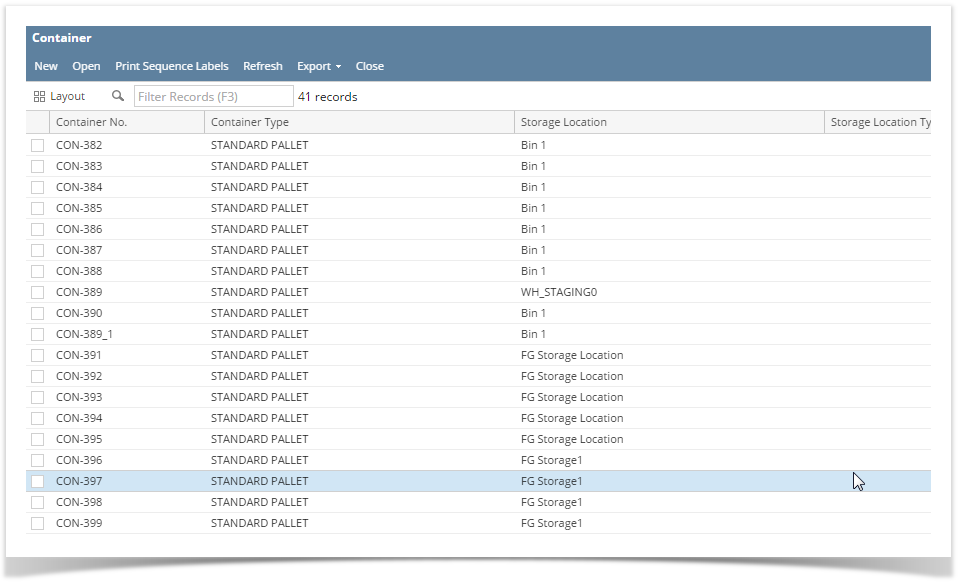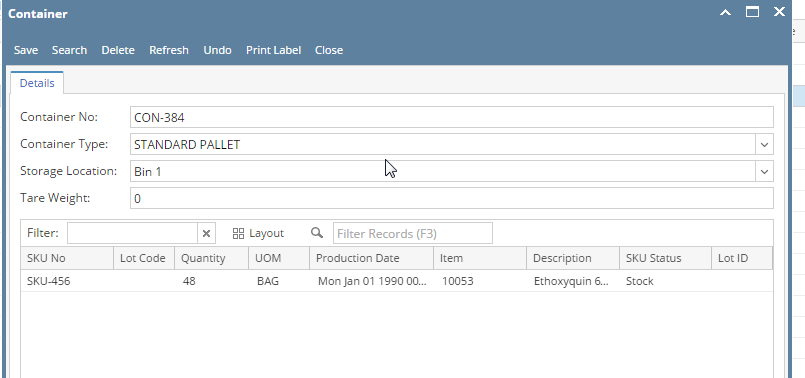Page History
Containers are used for storing and/or moving materials in a Warehouse. E.g.: Pallets, Drums, Boxes, etc. A Container holds a Stock Keeping Unit (SKU).
Accessing Container
1.Select ‘Warehouse’–> Container.
This opens the Container manager screen as shown below:
Figure: Container Manager
2. Select any Container and Click on Open
Or
3. Double click on any Container
4. Container Details screen will appear
Figure- Container Details
NOTE:
- An SKU is never placed directly in a Location. It is always placed in a Container of some type.
- In an ideal situation, a Container would contain only one SKU. However, there is no restriction against a container holding multiple SKUs, even if the SKUs represent different products or different lots.
- Container can be moved from one location to other location irrespective of the status of container in Outbound order i.e., even if the container is associated with pick task.
The tool bar of the Container Manager Screen has the following menus:
Menu | Description |
New | Allows the user to create a new Container |
Open | Allows the user to view details of the selected Container |
Print Sequence Labels | Prints a sequential group of container labels, which are usually used during check-in or splitting SKUs |
Refresh | Allows the user to Refresh the page |
| Export | |
| Close |
Clicking ‘New’ or ‘View Detail’ button opens the Container Detail screen. When the ‘New’ button is clicked, the screen opens with most fields as blank and some fields with default values. When the ‘View Detail’ button is clicked, the screen opens with all the details of the selected Container which may also be edited.
Clicking ‘New’ will open the following screen:
Figure 334: Container Detail - Container
•The ‘Container Detail’ screen consists of two tabs:
oContainer- Users can use this tab to create a new container or view an existing container detail, or even edit a container detail
oSKU- All the existing SKUs for the selected container are displayed in this tab. While adding a new container, this tab will not display any SKU.
•Normally, Container records are created when a pallet of Finished Goods is received from production or for an Inbound order.
The fields under the ‘Container’ tab are listed below:
Field | Description | Type | Example | Validation |
Container ID | Container ID is auto-generated by the application while creating a new container | Display Text | 0001013507 | Mandatory |
Container Type | Select the type of Container (if the desired Container Type is not available in the lookup, user may create a new container type by clicking button | Drop-down List / Lookup | STANDARD PALLET | Mandatory |
Unit | Select the desired active warehouse Storage Unit by clicking | Display Text | NC0202A< | Mandatory |
Last Updated By | Displays the name of the logged in user. Can be seen when container details are saved. | Display Text | John | NA |
Last Updated On | Displays the date and time of the update. Can be seen when container details are saved. | Display Text | 10/1/2011 13:07:28 | NA |
Clicking ‘SKU’ tab displays the following:
Figure 335: Container Detail – SKU (Card View)
•The record displays details like SKU ID, Lot Code, Serial No, Qty etc.
•The options allow the user to view an SKU record in different styles of Card Views.
Figure 336: Card Viewing Options
Number | Display Type | Description |
1 | One Card | Displays retrieved data in a single card; one at a time |
2 | One Row | Displays retrieved data in one row |
3 | One Column | Displays retrieved data in one column |
4 | Multiple Rows | Displays retrieved data in multiple rows (depends on the card height) |
5 | Multiple Columns | Displays retrieved data in multiple columns (depends on the card height) |
6 | Carousel Mode | Displays retrieved data in a format where users can mouse over the results to highlight them |
•A ‘Customization’ button is present using which users can design the templates of the data cards.
NOTE: Empty containers are automatically deleted by the system.
Important
Deleting a Container associated with an SKU will delete all the SKUs and tasks associated with it.




